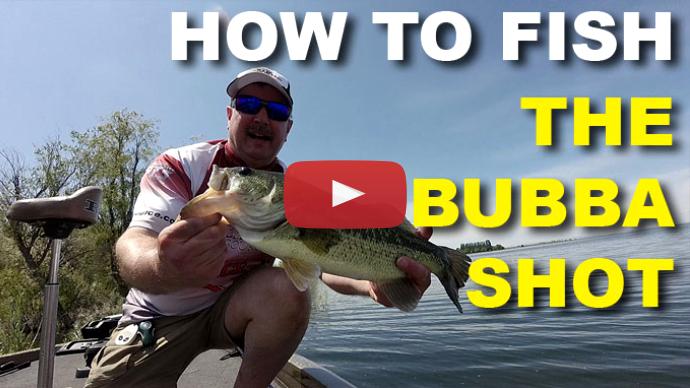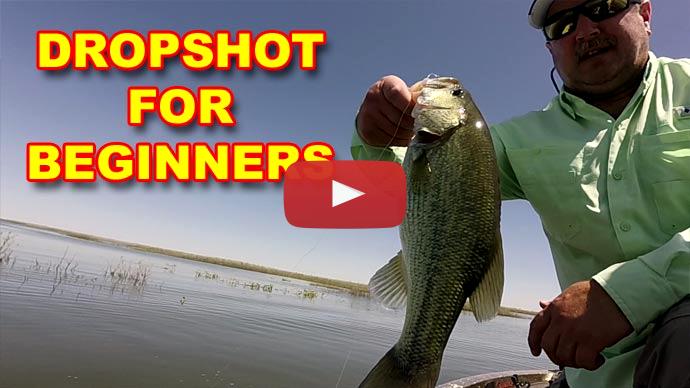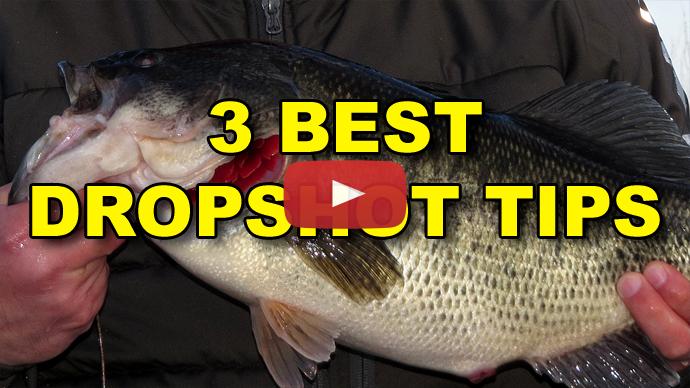Keri: I got a fish, believe it or not. I threw her way out there in the middle of nowhere and got a fish.
Glenn: It's just sitting on these little drops.
Keri: Nice.
Glenn: That's a good fish.
Keri: Come here, little guy. In the middle of nowhere. It's in a dark spot and that's...just it. I threw to a dark spot. Another little pound-and-a-halfer.
Glenn: Hey, folks. Glenn May here with BassResource.com, and today we're talking about drop shotting. I take a lot of people out fishing, I take them drop shotting and I see them making the same mistakes over and over again. So, I thought I'd make this video with the seven top mistakes that I see anglers make when they're drop shotting. Hopefully, this is gonna help you out.
The first one that I see, the most common one that I see is that they overwork the bait. The thing is with us bass anglers, we're used to working our baits. We're used to your jigs with plastics, we're popping it up and down, moving around, with crankbaits, we're doing pause and stop and go retrieves, even topwater, we're twitching it or doing something. So, we're used to imparting the action on the lure.
It's the exact opposite with drop shot. With a drop shot, you don't wanna really move it at all, it's supposed to look like a baitfish that's basically suspended in the water, not moving around that much, really lethargic. This is a technique you use when the bite is slow. So, the whole ecosystem is slowed down, they're not moving around much. So, if you're imparting a lot of action, it looks unnatural.
Basically, what you need to do with a drop shot is you just hold it in place. You wanna keep that weight on a bottom. Every time you lift that weight up the bottom, then you've killed it because now the weight is gonna fall and that bait is gonna fall at an unnatural rate and it's gonna look unnatural to the bass.
If you're shaking it, you wanna shake the bait and not the weight. That's the key thing. Keep that weight on the bottom.
Basically, you just hold it out there and don't move it at all. You got the waves that are lapping up against the line, so it's imparting some action there, a little bit of current may be underwater. If you're in a boat, you're moving a little bit or the boat is rocking a little bit. Even your hand, even if you're on the bank, just holding it in your arm, you can't hold it steady like a mannequin. It's still moving around. All of that adds up to enough action underwater that's gonna make that bait look alive. And that's all you need to do. Stop making so much movement on it, guys. You'll catch more bass that way, I promise you.
All right. The next common mistake that I see anglers do is they rig it wrong. Primarily, they rig it crooked on the hook. These baits, the three-inch baits, maybe four-inch baits, there's very little to no room for error if you got it on crooked. You've got to get that bait on absolutely straight on the hook.
Take the time, slow down, make sure it's on there because if it's off even by a little bit, that bait is gonna spin and you'll see it. When you cast it out there or when you're reeling it back in, you'll see the bait spinning like that.
It's two things. Number one, it doesn't look correct in the water. It's gonna look unnatural, but also now you're imparting line twist in your line. Guys have a lot of problems with line twist on spinning outfits. Most of the time it is because the bait is on crooked and the bait spins. So, slow down, take the time to make sure that's on nice and straight. And you're gonna catch a lot more fish and have a lot less trouble.
Keri: Come here, you little feisty thing. Come over, you little feisty thing. There you are. You feisty one. Not happy at all about having that in its mouth. Another little drop shot bass. Come hither. Another little guy. He was almost behind the boat. They're cold.
Glenn: The next mistake that I see drop shot anglers make is that they put the hook in the bait wrong. This is an easy mistake to do. I laugh, but honestly, it's the easiest mistake.
Okay. We're gonna blow this up. The bait is like this. This is the body of the bait. If you put the hook in at an angle like that or like that, even though the body is straight, but your hook is at...the body is like this, the hook is like this, it's not gonna run right. Or if your body is like this and you put the hook in over here and bring it up over here so it's not in the center, that's gonna impart an unnatural action on the bait and again, it could add line twist to it.
So, you got to be very careful with these two points I just made. One, it has to be absolutely straight on the hook and number two, that hook has to be right dead center, center mass, perfectly straight up and down in that body in order for it to look right in the water. Those two things right there are gonna really help you with your successful drop shotting.
Let's move on to the next common mistake I see. And that is anglers, they set the hook way too hard. Us bass anglers, we're used to fishing lures that have big hooks on them and strong beefy rods and such and so. The bass mouth is bony. So we're used to, bam! Crossing their eyes, set that hook hard. Right?
You need to do that. That is the correct hook set for most lures.
Not with drop shot. The drop shot, you got a thin wire hook, it's not very big. It's maybe a one-aught, probably size one or two. Very thin. It sets the hook itself. If you guys have fished for trout or for crappie, then you know what I'm talking about. The hook set you need to do is really nothing. You set it too hard and you're actually gonna tear a hole on the fish's mouth, or you're just gonna rip the hook right out of his mouth. With these little bitty hooks, it takes nothing to set.
Instead of reefin' on him, you just reel down and pull. Maybe reel and pull. It's just a pressure set. You're not reef, it's just easing up and reeling it, just lean into it. That's it. The fish fighting back to the boat, he'll set the hook himself. I promise you, you'll catch a lot more fish this way.
I see a lot of guys lose fish with drop shot, and it's because they're setting the hook way too hard. Don't do that. Just ease up on it and you'll catch a lot more fish that way.
The next mistake that I see drop shot anglers make is that they're using the wrong rod. Along the lines of the hook set, the rod has to have a lot of bend and give in it. It's not the stiff, strong rod that most anglers use for other types of bass fishing. Here, you're using a medium-power rod with a light action tip. It's got a lot of bow and flex into it.
And the reason being is you want that rod to act as a shock absorber, both during the hook set and especially during the fight back to you. As the fish makes a lunge or run for it, that rod is gonna give and it's a lot harder for that hook to rip out of the fish's mouth and it's gonna keep him pinned if you have the right rod. So, make sure you're using a more limber rod than you normally would use for other bass fishing techniques. There we go.
Keri: Oh, you got.
Glenn: That's a good one. That's a good one. Oh, boy. There we go. There we go.
Keri: That's a fighter too.
Glenn: Yeah. He is. Smallmouth, don't give up. Here we go. Here we go.
Keri: That's a little bit of fish. He's been spear bass humping.
Glenn: Probably a cormorant. That's a decent fish.
Keri: Yeah.
Glenn: We'll take it. On a reaper.
Keri: Okay.
Glenn: Alright, buddy. These guys love to fight. I'm gonna let you go.
The next mistake that I see bass anglers make for drop shotting is using the wrong line. Line makes a critical difference in how that bait performs underwater. When I first started drop shotting many decades ago when it first came out, when was that? I don't know, '80s? '90s? I was using 10-pound line on spinning gear. And it worked. It worked well, but I had so many of my friends that were doing better drop shotting and they kept telling me I need to downsize on my line.
And the reason being is that line, the stiffer or the heavier, the higher pound test line is, the stiffer it is, the less action that that bait has. It actually impedes the action of that bait so it doesn't look as natural underwater.
Well, I was really resistant to go to a lower pound test because I didn't wanna have more break-offs or retie it as much. But finally, I convinced myself to go to eight-pound test. Whoa, big step.
Well, not only did I not have those problems with more break-offs and having to retie, but I caught more fish. Just that little bit of a difference made a huge change in the way that bait acted in the water, and I was able to catch more fish.
Now, as some of you guys know, I go out and I fish with the pros a lot and I've got a lot of friends that are pros. And one of them, Aaron Martens, a good friend of mine. He's like the godfather of drop shotting. He's the king of drop shotting and he kept telling me that I need to go to smaller test pound, minimum six. He was saying even four-pound test. "Get it down there, Glenn, because that makes a big difference in the line with the way that it imparts the action on the bait." The lighter that test, the more that bait flows freely.
And so finally through his guidance, I went to six-pound fluorocarbon line. I use Seaguar Tatsu fluorocarbon line. And the reason for that is Tatsu is the most limber flexible line, fluorocarbon line that's out on the market today. Period. And so it lets that bait act completely natural, it lets it flow freely. Plus, the line is low visibility and high sensitivity. So, some of those bites are really soft. So, that sensitivity in that line is important.
This is not the time to use braid, guys. I don't even care if braid to fluorocarbon and you're using leader. Braid has no give in it whatsoever. And here we are going back to that hook being ripped out of the fish's mouth. You need your whole setup to run in concert with each other. And braid without having any give in it, you've increased your odds of that hook being ripped out of the fish's mouth. Plus, braid is more buoyant. So, when you cast out, you're gonna see this line curve down in the water. So, you end up actually having more line out than you need to or more line out than you would have if you were using fluorocarbon, which is more of a straight connection. So, your sensitivity is actually going down by using braid. So, braid has its places, but not with drop shotting. I just use straight fluorocarbon here and it really has increased my success.
Keri: Ooh, you're pulling like you're mean.
Glenn: Yeah. That's a bit better. That's a good fish. There you go. That's a largemouth.
Keri: Oh boy, you are not happy with me.
Glenn: There we go. That does the trick.
Keri: That does the trick. Drop shot fish. There we go. There we go. Much better fish. Much better.
Glenn: That works.
Keri: That's what we've been waiting all day for.
Glenn: That's a good one.
Keri: Thank you, dude. Got a little belly on him.
Glenn: Yeah. That works.
Keri: Got a little fish drop shotting. Here we go, baby. Thank you for the play. That was fun. Slowly just saunters off.
Glenn: So, the next mistake that I see drop shot anglers make is that they don't fish drop shot shallow. Now, drop shot has earned a solid reputation of being a deep water technique. And for good reason, it works really well. And with a light line that you're using when you hook up with a fish, there's nothing there for the fish to wrap around to get hooked on and for you to break off on. So, it's a great technique for fishing the deeper water.
However, drop shot is a great setup to use when the fish are shallow. Particularly, if the water's clear, you're fishing say a rocky flat or an area of chunk rock or maybe docks that have very little vegetation around them, drop shot works really well for those conditions.
But don't limit yourself to that. If the weeds are thick or the cover is a little bit heavier, then you can upsize your gear. Use a heavier stout and more stout rod. Now, you can flip the braid, use a stouter hook, a little bit bigger bait. And you can go in there and flip and pitch it into the weeds.
This is actually... people call that bubba shotting. I got a whole video just on bubba shotting. I'll link to it down here in the description. You can check it out and learn more about that. But essentially, it is just a beefed up version of a drop shot rig and you're fishing it shallow. So, don't think that the only reason or the only way you can fish a drop shot is deep, it is very effective shallow as well.
All right. So, those are the seven common mistakes that I see drop shot anglers make. I hope this video helps. For more tips and tricks like this, visit BassResource.com.



